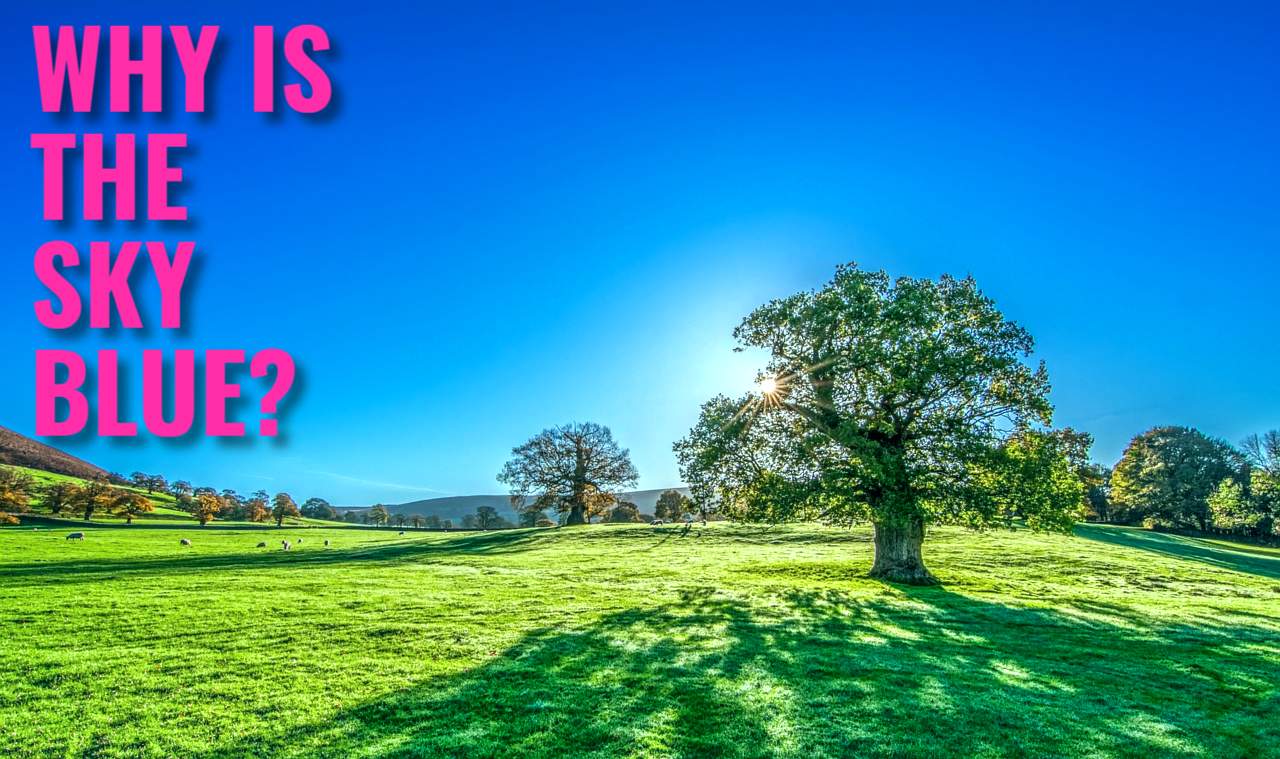Table of Contents
Have you ever wondered why the sky appears blue? Many of us have looked up at the sky and been mesmerized by its beautiful blue hue – but what is it that creates this effect? This article will explore why the sky is blue, and explain some of the science behind it. We will discuss how light interacts with gases and particles in the Earth’s atmosphere to create a beautiful blue sky.

Why the sky is blue?
The sky appears blue to us because of a process called Rayleigh scattering. Sunlight is composed of various colors, or wavelengths, that appear white when combined. When sunlight enters Earth's atmosphere, it interacts with the molecules in the air (mostly nitrogen and oxygen).
These molecules scatter the sunlight in all directions but scatter shorter, blue wavelengths more than longer, red wavelengths. This means that when we look up at the sky during the day, we see mostly scattered blue light.
Interestingly enough, this phenomenon also explains why sunsets appear orange and red. As the sun begins to set on the horizon, its light has to pass through more of Earth's atmosphere before reaching our eyes. The extra distance causes even more scattering of blue and green wavelengths while allowing more reds and oranges to pass through unobstructed.
In conclusion, while it may seem like a simple question on the surface – “why is the sky blue?” – understanding how Rayleigh scattering works gives us deeper insight into how sunlight interacts with our atmosphere and ultimately shapes our perception of color in nature.

Light energy beaming
Light energy beaming is the transfer of electromagnetic radiation in the form of light waves. Light contains a spectrum of colors that are dispersed when it passes through a prism. The different colors of light have different wavelengths, with red light having the longest and violet light having the shortest wavelength.
Light from the sun appears white because it is composed of all the colors in the visible spectrum. When light enters the Earth's atmosphere, it is scattered by particles in the air, resulting in a blue color to the human eye. This phenomenon is also observed in the Martian sky, where the atmosphere is thin, causing the red light to scatter and giving the sky a blue hue.
Light energy beaming is a vital aspect of our daily lives, with applications in communication, medicine, and entertainment, among others

Reflection: Light and Color
The blue color of the sky is a result of the scattering of light by the Earth's atmosphere. The short-wavelength blue light is scattered more than other colors in the spectrum. As sunlight passes through the atmosphere, it collides with air molecules and scatters in all directions. Blue light has shorter wavelengths than other colors, causing it to scatter more widely throughout the sky. This is why we see blue when we look up at a clear sky during daytime.
However, during sunrise and sunset, when sunlight travels through a greater amount of atmospheric particles, longer-wavelength colors like red and orange are able to penetrate through to our eyes while shorter-wavelength colors like blue and violet are scattered outwards. This results in beautiful hues of pink, purple, and gold that fill the evening sky.
Understanding how light interacts with matter can help us appreciate the beauty around us even more. By reflecting on these scientific concepts that govern something as simple as why we perceive certain colors during different times of day, we can gain a deeper appreciation for nature's wonders.

Particle Theory: Rayleigh Scattering
Rayleigh Scattering is the phenomenon that explains why the sky appears blue to our eyes. According to the particle theory of light, when sunlight enters Earth's atmosphere, it encounters gas molecules and tiny particles such as dust and water vapor. The different colors of light have different wavelengths, with blue having the shortest wavelength. These short wavelengths are easily scattered by the particles in the atmosphere.
As a result of Rayleigh Scattering, more blue light is scattered in all directions than any other color. This means that when we look up at the sky during daylight hours, we see a bright blue hue because our eyes receive this scattered blue light from all around us.
However, during sunrise or sunset hours when sunlight has to travel through more of Earth's atmosphere before reaching us, most of the shorter-wavelength (blue) light gets scattered away by larger atmospheric particles leaving behind longer-wavelength (red) hues – which is why sunsets appear pinkish-orange in color!

Wavelengths of Visible Light of sky blue and sunset red
The colors that we see in the sky are all part of the visible light spectrum, which is made up of different wavelengths. These wavelengths range from around 400 nanometers (violet) to 700 nanometers (red). When sunlight enters Earth's atmosphere, it interacts with molecules in the air such as oxygen and nitrogen. This causes the shorter wavelengths (blues and violets) to scatter more than the longer wavelengths (reds and oranges), resulting in a blue sky during daytime.
It's important to note that this scattering effect occurs more strongly at lower altitudes because there is a greater concentration of air molecules closer to the ground. That's why when you look up at a clear blue sky, it appears lighter near the horizon and darker overhead. The same principle applies during sunrise and sunset when sunlight must pass through more atmosphere before reaching our eyes, causing it to appear redder or orange.
Understanding how different wavelengths of visible light interact with our atmosphere can help us appreciate the beauty of nature surrounding us every day.

Blue Skies Everywhere
The color of the sky has always been a curious topic for many people. The blue skies we see daily are due to the scattering of sunlight by our atmosphere. Sunlight consists of different colors with varying wavelengths, and as it passes through our atmosphere, it interacts with air molecules, water vapor, dust particles, and ozone gas. These tiny particles scatter light in all directions but mostly towards the blue end of the spectrum.
As sunlight passes through Earth's atmosphere, it collides with nitrogen and oxygen molecules which make up 99% of the air we breathe. The shorter violet and blue wavelengths are more likely to collide with these molecules and scatter into various directions creating a bluish hue that is visible from earth’s surface. This phenomenon is known as Rayleigh scattering.
In summary, when we look up at the sky on a sunny day, we see blue skies everywhere because of how light interacts with gases present in our atmosphere. It's fascinating to know that something so simple can have such an incredible scientific explanation behind it!

Human Perception and Preference
The human perception of color is a fascinating topic that has captivated scientists and artists alike for centuries. One of the most intriguing questions in this field is, “Why is the sky blue?” The answer lies in the way our eyes perceive light waves.
When sunlight enters Earth's atmosphere, it encounters molecules like oxygen and nitrogen which scatter the light in all directions. This scattering causes shorter wavelength colors such as blue and violet to be scattered more than longer wavelengths like red and orange.
This phenomenon leads to our perception of a blue sky during daytime hours. However, at dawn and dusk when the sun is lower on the horizon, its light must pass through more atmosphere which scatters out even more of the shorter wavelengths, leaving behind longer wavelengths like reds and oranges. Hence, we see colorful sunrises and sunsets with hues ranging from fiery reds to soft pinks.
Overall, human perception plays a crucial role in determining our preferences for certain colors based on various factors such as environmental conditions or cultural influences. Understanding these perceptions can help us better understand how people interpret messages conveyed through color choices in marketing materials or other forms of media.

Conclusion: Summary of Reasons
In conclusion, the question of why the sky is blue has been answered through a variety of scientific explanations. The first reason is that the Earth's atmosphere scatters sunlight in all directions and blue light is scattered more than any other color due to its shorter wavelength.
Secondly, as sunlight enters our atmosphere during sunrise or sunset, it must pass through more of the Earth's atmosphere causing even more scattering resulting in a reddish-orange hue. Finally, weather conditions such as pollution or smoke can affect how much sunlight gets scattered producing different colors in the sky.
Overall, understanding why the sky appears blue helps us appreciate and comprehend natural phenomena that we often take for granted on a daily basis. It also serves as a reminder of how science plays an important role in explaining our world and enhancing our knowledge about it. While there are many mysteries yet to be uncovered, we can find comfort in knowing that with each scientific discovery we come one step closer to unlocking more secrets about our universe.

Related articles
Space Place NASA Blue sky, Why is the sky blue?
https://spaceplace.nasa.gov/blue-sky/en/
RMG Why is the sky blue? why sky blue
https://www.rmg.co.uk/stories/topics/why-sky-blue
McGill Why is the sky blue or better yet why is the ocean blue?
Sky at night magazine Why is the sky blue?
https://www.skyatnightmagazine.com/space-science/why-is-the-sky-blue/
Space Why is the sky blue?
https://www.space.com/why-is-the-sky-blue
SC Links Why is the sky blue?
https://scijinks.gov/blue-sky/
Math UCR Why is the sky blue?
https://math.ucr.edu/home/baez/physics/General/BlueSky/blue_sky.html
The Conversation Why is the sky blue and where does it start?
https://theconversation.com/curious-kids-why-is-the-sky-blue-and-where-does-it-start-81165
Science How stuff works. Why is the sky blue?
https://science.howstuffworks.com/nature/climate-weather/atmospheric/sky.htm
Science made simple Sky blue
https://www.sciencemadesimple.com/sky_blue.html
Wonderpolis Why is the sky blue?
https://www.wonderopolis.org/wonder/why-is-the-sky-blue/
Encyclopedia Britannica Why is the sky blue?
https://www.britannica.com/story/why-is-the-sky-blue
Nerd Momma Why do we dream?
https://nerdmomma.com/why-do-we-dream-uncovering-the-nightmare-secrets-of-dreaming/#more-1647
